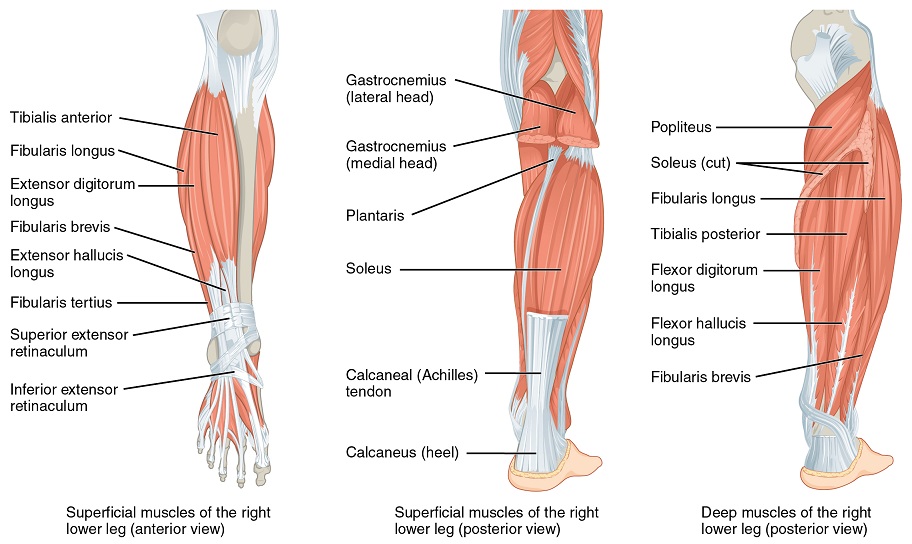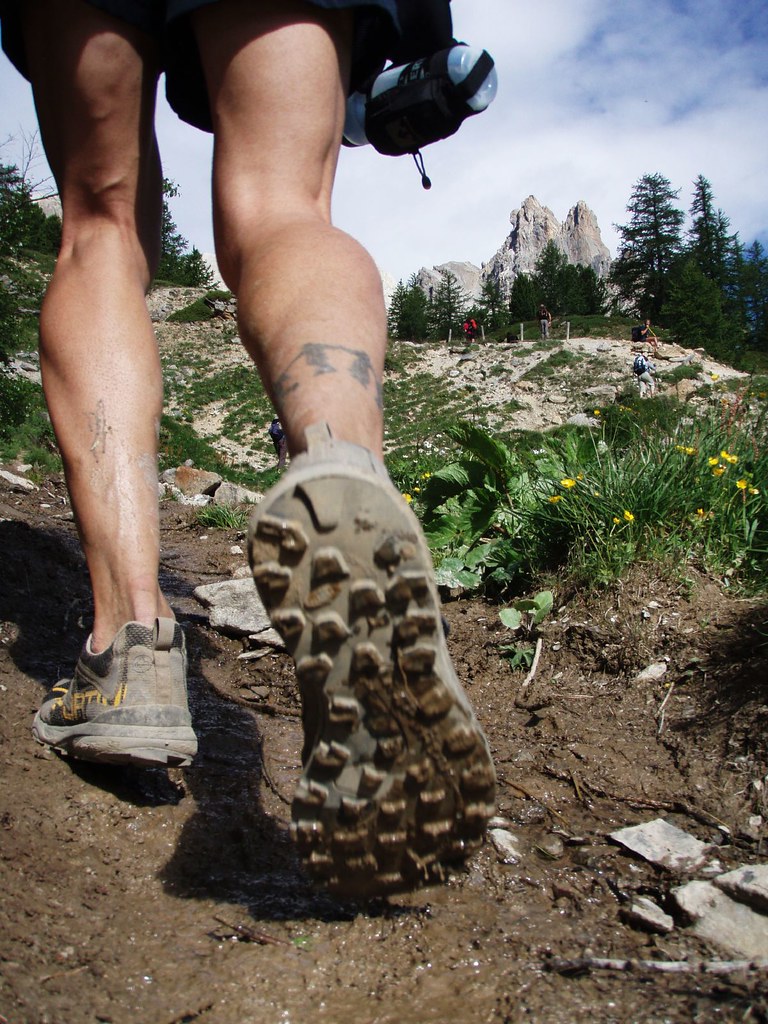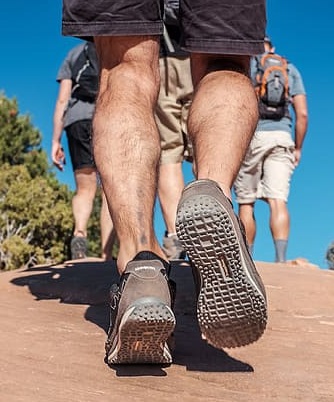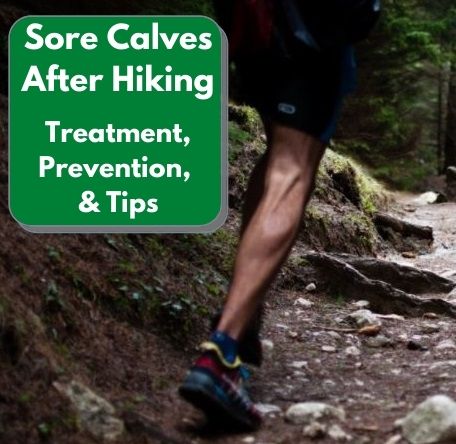As hikers, we’ll push through almost anything to do what we love, but dealing with sore calves after hiking is definitely not pleasant. This is why it’s so important to find ways to take care of your calves after long hikes to reduce the soreness and also take steps to prevent sore calves from hiking in the future.
In this guide, we’ll explain why your legs are sore after hiking, how to take care of it, and how to prevent your calves from getting so sore from hiking going forward.
Common Causes Of Sore Calves After Hiking

Sometimes your body won’t let you know that you’ve “overdone it” until the next day after a long hike, which is easy to do – especially if you’re new to hiking.
There’s a scientific term for this called DOMS (or delayed onset muscle soreness), which the pain and stiffness felt in muscles several hours to days after strenuous or unaccustomed exercise.
You’ll feel the most soreness in your calves between 24-72 hours after a long hike, and then it’ll start to subside.
Your calf muscles are made up of the gastrocnemius (the large calf muscle) and the soleus (the thinner muscle running along side your leg between your ankle and the larger calf muscle).
Your Achilles tendon also plays a role as it anchors the muscle fibers to your heel bone, and it may be sore as well.
Now that we know what is going on to cause the soreness, let’s cover the most common situations where it occurs.
General Overexertion
You’ll find the most common causes of post-hike calf soreness are caused by doing too long of a hike too soon (a regularity for new hikers), but can also be caused by irregular hiking (aka weekend warriors) or even going on multi-day hiking trips when you may only be accustomed to day hikes.
Lactic Acid Buildup
When your body breaks down glucose for energy during exercise, lactic acid is produced as a byproduct of that process.
Normal amounts of lactic acid are made by your body through everyday activity and are removed through circulation and sweat, but sometimes (like when your body is working hard while hiking) your body doesn’t have a chance to remove the lactic acid at the rate it’s being made, causing a buildup in those muscle groups that are overworked.
In this case the overworked muscle group is your calves.
Calf Pain When Hiking Uphill
You may also experience pain in your calves when hiking up steep terrain.
This is because your ankles and feet have a wider range of motion than your calves do, so your calves must work much harder to move your body uphill, fatiguing them faster than if you were hiking downhill.
You can reduce calf pain while hiking uphill by walking in a switchback or zig-zag pattern to reduce the strain on your calves, hiking more slowly, and taking breaks as needed.

How To Treat Sore Calves After Hiking
So you went hard on the trail and now your calves are burning with every step… but you can’t be laid up in bed or on the couch forever, right?
Take these steps to get some calf relief right away.
Roll It Out
You can use a foam roller or fitness massager to work your muscles.
Doing this decompresses and relaxes your stiff muscles back to their natural position and releases the tense trigger points built up in the fascia (or casing) of your muscles.
It also increases circulation and prepares the body for movement by stretching, loosening, and otherwise “warming up” the muscles for activity.
Try Hot And Cold Soaks
You can soak your calves in both cold and warm water for release, or you can use ice packs and heating pads as well.
The cold will reduce swelling in your calf muscles and the heat will soothe them.
Just give your calves time to adjust between each temperature switch.
Massage Those Calves
The benefits of massage are similar to foam rolling but also have the added benefit of being able to go deeper and focus on a specific spot in your calf muscles.
Massage your calves with your hands, using an oil or lotion for an extra perk.
Take It Easy
Try to limit your activity to allow your calves to recover from the long hike.
Skip any workouts or portions of your routine that are hard on your lower body or calf muscles and avoid wearing shoes that place extra strain on these muscle groups.
Walk on soft surfaces if possible, avoiding cement or pavement if you can.
Stretch Your Calves
Stretching your calves is a great way to prevent calf pain from hiking but is also a good way to relieve the soreness you’re dealing with now.
Take a look later in this guide for our walkthrough of the best calf stretches including the calf wall stretch, heel drop stretch, and downward dog stretch.
Jump Ahead: Best Stretches For Sore Calves After Hiking

How To Prevent Sore Calves After Hiking
As the old adage goes, an ounce of prevention is worth a pound of cure.
Follow these steps to make sure you’re not dealing with calf soreness after hiking next time.
Stretch Your Calves Before Hiking
Stretching out your calves is a great way to get them ready for exercise and prevent soreness and injury.
Check out the different hiking calf stretches you can do below.
Wall Stretch
Wall stretches are easy and require no equipment to perform – just a wall and your body!
You can also modify this exercise with either a straight leg to target the gastrocnemius, or a bent knee to target the soleus.
Here’s a video showing how to do a wall stretch:
Heel Drop Stretch
Heel drop stretches can be done using only your body and a raise platform like a stair or step, and can also be modified to target the large calf muscle or soleus depending on your needs.
Here’s a video explaining how to perform a heel drop stretch:
Downward Dog
Although popularized by yoga, the downward dog is a great way to do a deep stretch on the muscles in your calves.
Here’s how to properly execute the downward dog:
Wear Good, Well-Fitting Hiking Footwear
The shoes and/or insoles you wear while hiking can play a big role in how your calves feel after a long trek on the trail.
You must ensure that your ankle and arches have good support and that your boot helps keep your heel in place.
We won’t go fully into everything here, but check out the following helpful guides for an in-depth explanation:
- How Should Hiking Boots Fit? An In-Depth Guide
- The Best Men’s Hiking Boots Under $100
- The Best Women’s Hiking Boots Under $100
Try Hiking Sticks
Hiking sticks (also known as trekking poles) help to incorporate your upper body into your hikes and also decrease the load on your lower body and calves.
They’re affordable and also offer increased safety while you’re traversing up or down slopes.
Check out how to size hiking poles if you go this route.
Build Up Your Calf Muscles
If calf soreness from hiking is caused by overworking them, you can consider training your muscles up to handle bigger workloads like longer hikes.
Perform exercises like calf raises (weighted or unweighted) on the floor or on stairs, increasing the weight and number of reps over time to build up those calves.
Check out the instruction below on how to do a calf raise properly:
Stay Hydrated
You may think it’s obvious, but proper hydration is critical for your muscles to function and recover properly, so always bring enough water for your hike.
Check out our guide on the best way to carry water while hiking for some great ideas.
Try Compression Clothing
Compression socks for hiking and other compression garments like compression pants can help prevent and reduce calf soreness post-hike, so consider trying this out.
Prepare The Rest Of Your Body
Make sure you’re in the best overall shape for your next hike.
We’ve put together the following helpful guides to aid you here:
- 6 Exercises To Give You Explosive Power When Hiking Uphill
- How To Train For Hiking On A Treadmill
- How To Prepare And Strengthen Your Knees For Hiking
- How To Prepare Your Feet For Hiking
Calf Soreness Vs Calf Pain After Hiking – Know The Difference
Soreness will go away in a few days and may feel like a dull ache or will present itself when you use your calf muscles, but pain can feel like a constant stabbing or shooting sensation that actively prevents you from doing your normal activities.
If you are considering that you are in pain versus just soreness, have a professional check it out as soon as possible so you can get treated properly, as pain doesn’t just “go away”.

